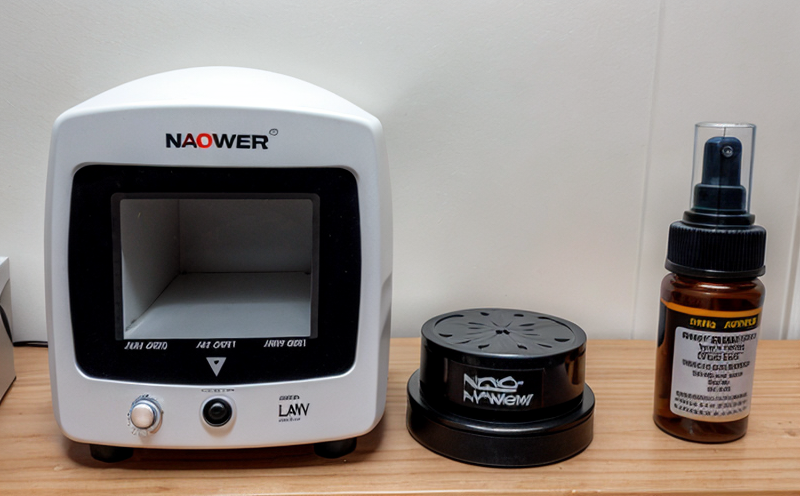ISO 13320 Laser Diffraction Particle Size Distribution for Nanopowders
The ISO 13320 standard for laser diffraction particle size distribution is a cornerstone method in the evaluation of nanopowders and particulates. This service plays a crucial role in ensuring that materials meet the stringent requirements necessary for various applications, including but not limited to pharmaceuticals, electronics, and coatings.
The primary purpose of this test is to measure the particle size distribution of nanoparticles by utilizing laser diffraction techniques. The method involves shining a laser beam through a suspension of particles and measuring the angle at which the scattered light exits. This process provides detailed information about the size distribution, including the mean diameter, volume-weighted median, and other parameters.
The ISO 13320 test is particularly important for industries dealing with nanomaterials because it offers precise measurements that are critical for quality control and product development. For instance, in pharmaceuticals, accurate particle size distribution can influence drug efficacy and delivery mechanisms. In electronics, the correct size of nanoparticles ensures optimal performance in circuits and devices.
Specimen preparation is a critical step in this testing procedure. The sample must be homogenized to ensure that it represents an accurate cross-section of the nanopowders being tested. This often involves dispersing the particles in a suitable liquid medium, such as water or ethanol, which helps prevent agglomeration and provides a stable suspension for analysis.
The equipment used for this test includes specialized laser diffraction instruments capable of measuring particle sizes down to sub-micron levels. These devices are highly sensitive and precise, providing reliable data even for very small particles. The results are typically presented as graphs showing the cumulative distribution function (CDF) or percentage volume vs. diameter.
Understanding the particle size distribution is essential because it directly impacts the behavior of nanoparticles in various applications. For example, in drug delivery systems, smaller particles can enhance absorption rates and target specific areas within the body more effectively. In electronics manufacturing, the right particle size ensures optimal conductivity and reduces resistance in circuits.
The ISO 13320 test is widely recognized for its accuracy and reproducibility, making it a preferred choice among quality managers, compliance officers, R&D engineers, and procurement specialists. It helps ensure that materials meet the necessary standards set by regulatory bodies and industry best practices.
Why It Matters
The importance of accurate particle size distribution measurement cannot be overstated in industries dealing with nanomaterials. Particle size is a key parameter that influences the physical, chemical, and biological properties of nanoparticles. Understanding this distribution is essential for quality control, ensuring consistent product performance, and meeting regulatory requirements.
For instance, in the pharmaceutical industry, the particle size can affect drug dissolution rates and bioavailability, which are critical factors for therapeutic efficacy. In electronics manufacturing, particles that are too large may not fit into certain components, while those that are too small might be difficult to handle or process. Therefore, precise measurement is paramount.
The ISO 13320 test provides a standardized approach to particle size analysis, ensuring consistency and reliability across different laboratories and facilities. This standardization is crucial for maintaining quality standards and facilitating international trade of nanomaterials. By adhering to this method, manufacturers can ensure that their products meet the required specifications, thereby enhancing consumer safety and satisfaction.
Applied Standards
| Standard | Description |
|---|---|
| ISO 13320:2009 | Laser diffraction particle size analysis of dry powders. |
| ASTM E1481-17 | Particle size distribution by laser diffraction using the Mastersizer method. |
| EN ISO 9276 | Standard practice for particle sizing of dry powders by laser diffraction. |
| IEC 61853-4:2006 | Particle size distribution measurement using laser diffraction. |
The ISO 13320 standard is widely recognized and applied in the testing of nanopowders. It provides a robust framework for particle size analysis, ensuring that measurements are consistent and reliable across different laboratories. This standardization is particularly important given the global nature of many industries dealing with nanomaterials.
Why Choose This Test
- Precise measurement down to sub-micron levels.
- Highly reproducible results, ensuring consistency across different laboratories and facilities.
- Compliance with international standards, enhancing the credibility of your testing results.
- Standardized approach that facilitates international trade and collaboration in nanomaterials research and development.
- Potential for improving product performance by optimizing particle size distribution for specific applications.
- Enhanced safety and efficacy in industries such as pharmaceuticals, electronics, and coatings.
- Accurate measurement of particle size distribution is critical for quality control and compliance with regulatory requirements.
The ISO 13320 laser diffraction test offers numerous advantages over other methods. Its precision, repeatability, and adherence to international standards make it a preferred choice for industries dealing with nanomaterials. By choosing this test, you ensure that your materials meet the necessary specifications, enhancing both product performance and regulatory compliance.





